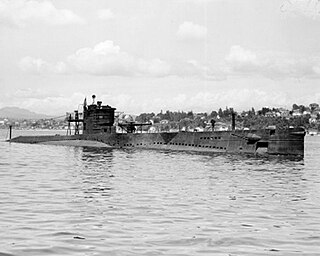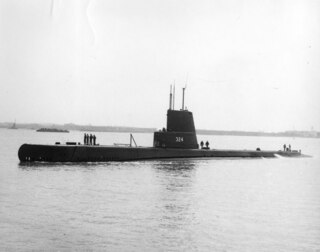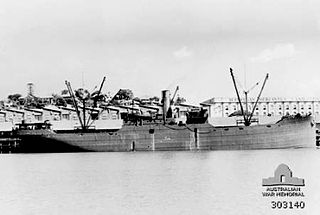
The Pearl Islands is a group of 200 or more islands and islets lying about 30 miles (48 km) off the Pacific coast of Panama in the Gulf of Panama.

USS S-26 (SS-131) was an S-class submarine of the United States Navy. She was lost in a collision with a friendly escort ship in late January 1942.

USS Grunion (SS-216) was a Gato-class submarine that sank at Kiska, Alaska, during World War II. She was the only ship of the United States Navy to be named for the grunion.

USS S-28 (SS-133) was an S-class submarine of the United States Navy. A diesel submarine, she served in World War II during which sank one Japanese ship. She was lost at sea with all hands in July 1944. Her wreck was discovered in 2017 at a depth of 8,500 feet (2,600 m) off the coast of Oahu.

USS Blenny (SS/AGSS-324), a Balao-class submarine in commission from 1944 to 1969, was a ship of the United States Navy named for the blenny, a fish found along the rocky shores of the Atlantic Ocean. During World War II, Blenny conducted four war patrols in the Java Sea and South China Sea between 10 November 1944 and 14 August 1945. She sank eight Japanese vessels totaling 18,262 tons. In addition, she is credited with destroying more than 62 miscellaneous Japanese small craft by gunfire.

USS Pilotfish (SS-386), a Balao-class submarine, was a ship of the United States Navy named after the pilot fish, a carangoid fish, often seen in warm latitudes in company with sharks.

USS R-8 (SS-85) was an R-class coastal and harbor defense submarine of the United States Navy.

Hammac was a steam tank ship built in 1920–1921 by Bethlehem Shipbuilding Corporation of Alameda for the United States Shipping Board as part of the wartime shipbuilding program of the Emergency Fleet Corporation (EFC) to restore the nation's Merchant Marine. Early in 1923 the vessel together with two other tankers was sold to General Petroleum Corporation and renamed Emidio. The tanker spent the vast majority of her career carrying oil along the West Coast of the United States as well as between West and East coast. In December 1941 she was shelled and damaged by the Japanese submarine I-17 and eventually wrecked with a loss of five crewmen.
Julius Hermann Kroehl was a German American inventor and engineer. He invented and built the first submarine able to dive and resurface on its own, the Sub Marine Explorer, technically advanced for its era. His achievements in architecture, civil and mechanical engineering were also significant.

Sub Marine Explorer is a submersible built between 1863 and 1866 by Julius H. Kroehl and Ariel Patterson in Brooklyn, New York for the Pacific Pearl Company. It was hand powered and had an interconnected system of a high-pressure air chamber or compartment, a pressurized working chamber for the crew, and water ballast tanks. Problems with decompression sickness and overfishing of the pearl beds led to the abandonment of Sub Marine Explorer in Panama in 1869 despite publicized plans to shift the craft to the pearl beds of Baja California.

James Preston Delgado is a maritime archaeologist, historian, maritime preservation expert, author, television host, and explorer.

The Pacific Pearl Company was incorporated in the American state of New York on November 18, 1863. Principal officers included John Chadwick as president, George Wrightson as treasurer, and Julius H. Kroehl as chief engineer. Other shareholders included William Henry Tiffany, Charles D. Poston and William M.B. Hartley. The company was a venture to harvest pearls and pearl shells in the Pacific Ocean. The first site chosen was Panama, in particular the Pearl Islands. After Kroehl recovered sufficiently from malaria he contracted while serving the Union Navy during the Vicksburg Campaign, he began designing and building a vessel at Ariel Patterson's Shipyard near the Brooklyn Navy Yard. Also being built nearby was the Intelligent Whale under the direction of Scovel S. Merriam. There were many companies active in submarine salvage at this time.

I-201 was the name ship of her class of high-speed submarines built for the Imperial Japanese Navy during World War II. She was commissioned in February 1945, and the war ended before she could carry out an operational patrol. She surrendered to the United States Navy in 1945 and was sunk as a target in 1946.
I-74, later I-174, was an Imperial Japanese Navy Kaidai type cruiser submarine of the KD6B sub-class commissioned in 1938. During World War II, she took part in the attack on Pearl Harbor, the Battle of Midway, the Guadalcanal campaign, the New Guinea campaign, and the Gilbert and Marshall Islands campaign and operated off Australia before she was sunk during her ninth war patrol in 1944.
German submarine U-576 was a Type VIIC U-boat of Nazi Germany's Kriegsmarine during World War II. She carried out five patrols, sinking four ships of 15,450 gross register tons (GRT) and damaging two more of 19,457 GRT. She was sunk on 15 July 1942 by depth charges from two US aircraft and gunfire from a merchant ship, near the East Coast of the United States. The wreck was discovered in August 2014.

Isla Gibraleón is a small, uninhabited Panamanian island that is part of the Pearl Islands archipelago in the Gulf of Panama. It is located 2 km (1.2 mi) west of Isla Casaya, and is part of a group of 200 or more islands and islets lying about 30 miles (48 km) off the Pacific coast of Panama. The island has an eight-kilometre (5.0-mile) coastline, five beaches, a mangrove swamp, and is covered in 153.18 acres (61.99 ha) of dense jungle. It has a total surface area of 277.62 acres (112.35 ha), which makes it the 12th largest island in the archipelago. Isla Gibraleón rises to a height of 11 metres (36 ft) above sea level, and is in the Eastern Time Zone (UTC−05:00).
Ro-60, originally named Submarine No. 59, was an Imperial Japanese Navy Type L submarine of the L4 subclass. She was in commission from 1923 to 1934 and from 1940 to 1941. Before World War II, she served in the waters of Japan. During World War II, she took part in the Battle of Wake Island in December 1941, and was damaged by a F4F-3 Wildcat during that battle. The submarine wrecked three weeks later trying to make it back to base, running aground on a reef and was abandoned. All of the crew was rescued by a Japanese vessel. Later in the war the vessel exploded after being strafed, scattering fragments of the vessel on that reef.

I-7 was an Imperial Japanese Navy J3 type submarine commissioned in 1937. She was a large cruiser submarine that served in World War II. She operated in support of the attack on Pearl Harbor, conducted anti-shipping patrols in the Indian Ocean, supported the Indian Ocean raid, and took part in the Guadalcanal campaign and the Aleutian Islands campaign. She was wrecked in the Aleutian Islands after a lengthy battle with the destroyer USS Monaghan (DD-354) in June 1943.

SS Coast Trader was built as the cargo ship SS Holyoke Bridge in 1920 by the Submarine Boat Company in Newark, New Jersey. The Coast Trader was torpedoed and sank 35 nautical miles southwest of Cape Flattery, off the Strait of Juan de Fuca in U.S. state of Washington by the Japanese submarine I-26. Survivors were rescued by schooner Virginia I and HMCS Edmundston. She rests on the ocean floor at.















